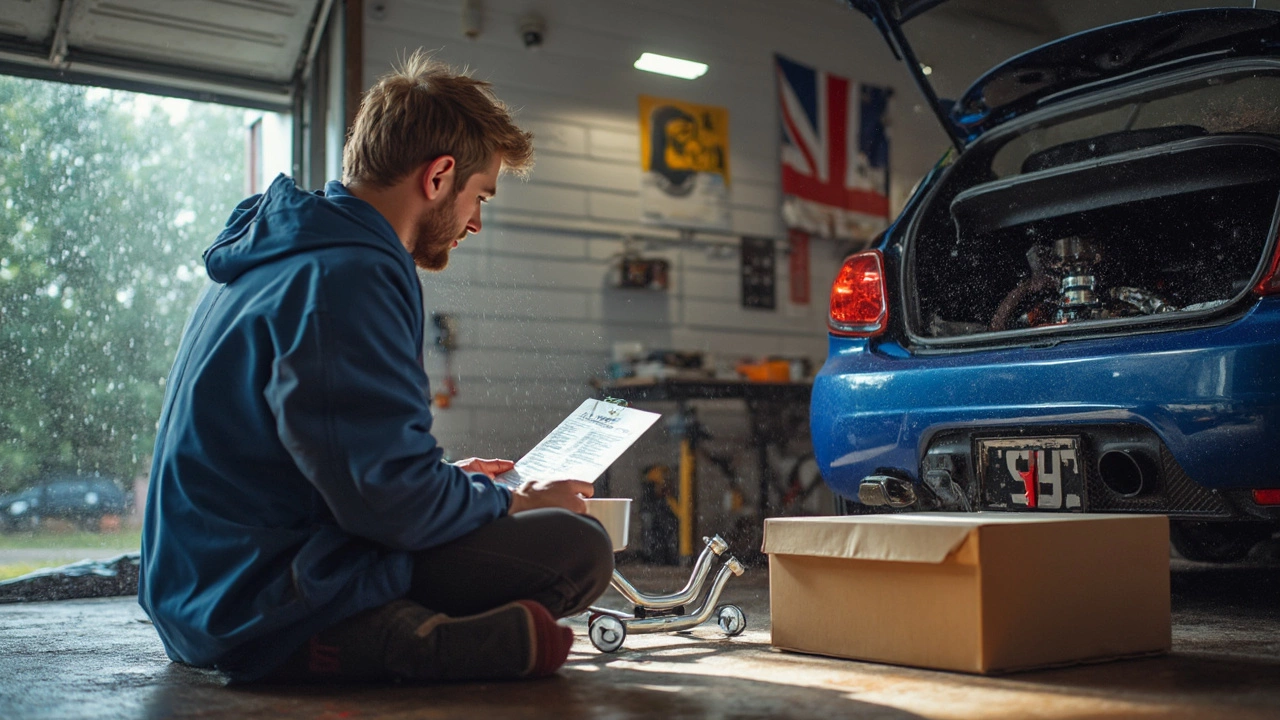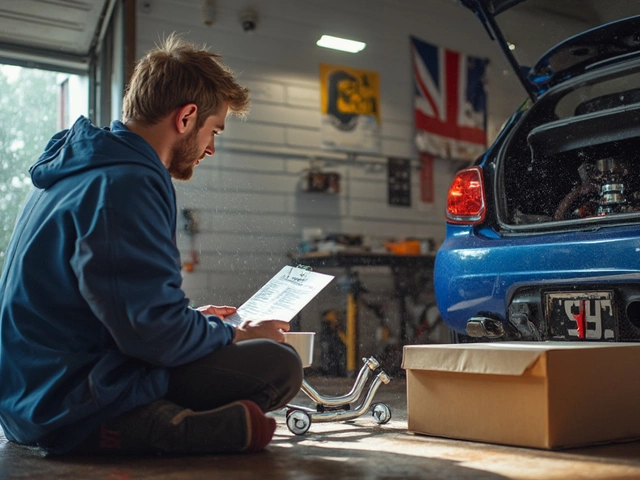So you’re ready to switch out your boring stock exhaust for something that sounds and performs better—awesome choice. But there’s one question almost everyone asks: how long is your car actually going to be stuck at the shop?
The truth is, installing a custom exhaust isn’t as simple as bolting on a pre-made piece. Every car is different. Some set-ups can be done before you finish scrolling through your feed. Others may take the better part of a workday—sometimes even longer if things get complicated or parts are delayed.
If you’re trying to plan your day (or week), you’ll want some honest answers on the timeline, plus a few tips to make sure everything runs smoothly. Let’s break down what really goes into getting that dream exhaust under your car, so you know exactly what to expect.
- What Goes Into a Custom Exhaust Installation?
- How Long Does It Really Take?
- What Can Affect the Installation Time?
- Tips to Make Installation Smoother
What Goes Into a Custom Exhaust Installation?
Let’s get real about what happens when you roll into the shop for a custom exhaust installation. It’s not just a mechanic grabbing some pipes and calling it a day. Here’s the rundown of what most shops actually do:
- Inspection and Planning: Before anything gets bolted or cut, the technician checks your current exhaust system, measures clearances, and plans out the new route. Every car model is different, so there’s no universal shortcut.
- Removing the Old Exhaust: This should be straightforward, but rusted bolts or welded parts can slow things down. Sometimes a simple removal turns into a battle with seized hardware.
- Test-Fitting New Parts: Nothing gets welded until everything fits right. They’ll mock up pipes and mufflers to make sure there’s no rubbing, leaks, or clearance issues around heat-sensitive stuff like brake lines or fuel lines.
- Fabrication and Welding: For a true custom job, most pipes have to be cut, bent, and welded to match your ride. This step is where skill really matters—the more complex your design (like dual exhaust or X-pipes), the more bending and welding is involved.
- Hanging and Mounting: The new exhaust needs solid hangers so nothing rattles or sags. Good mounting is key if you want it to last and sound right.
- Final Checks: Once it’s all connected, the shop checks for leaks and makes sure nothing touches the underbody or suspension. They’ll usually fire up the engine, give it some revs, and sometimes take it for a short drive to confirm it’s all solid.
Some shops prefer to make everything from scratch right on the lift. Others use pre-bent pipes or kits, especially on popular cars, which can speed things up. Still, even those jobs need some adjusting for a perfect fit—so it’s never slap-and-go.
| Step | Avg. Time (minutes) |
|---|---|
| Inspection & Planning | 30 |
| Removal of Old Exhaust | 30-60 |
| Test-Fitting | 20-40 |
| Fabrication & Welding | 60-180 |
| Hanging & Mounting | 20-40 |
| Final Checks | 15-30 |
Altogether, you’re looking at a process that needs skill and patience—especially if you want that new custom exhaust to sound and perform just right.
How Long Does It Really Take?
If you're hoping for a quick in-and-out, a basic custom exhaust installation on a common car can take about 2 to 4 hours. That’s usually if you’re working with a well-known vehicle where parts fit with no drama and the shop has your exhaust ready to go. For example, slapping a cat-back system onto a late-model Mustang or Civic is typically pretty routine for most exhaust shops.
But here’s where it gets interesting. If your car needs a full custom exhaust—think fabrication, special bends, or adjustments to clear tight suspension parts—you might be looking at a full day (5-8 hours) or sometimes, two days if unexpected issues pop up or the techs need extra time for welding and test fitting. Shops that are slammed with work might also ask you to drop your car off for a day or more, just so they can work it into their schedule.
| Installation Type | Time Estimate |
|---|---|
| Direct-Fit/Pre-Bent Kit | 2-4 hours |
| Custom-Fabricated | 5-8+ hours (sometimes 2 days) |
| Rare/Classic Cars | Varies (often longer) |
Something else to keep in mind: if you’re working with an older or rare car, you might hit snags like rusty bolts, seized parts, or missing hangers. Those issues can tack on unexpected hours (and sometimes extra cost).
Bottom line? If you just want a bolt-on replacement, block off a morning or afternoon. For full-blown custom setups, don’t be surprised if your car’s at the shop all day or overnight. It pays to ask your shop up front—most are used to customers asking about installation time and can give you a much more exact window based on your car and chosen system.

What Can Affect the Installation Time?
When it comes to a custom exhaust installation, the finish line isn’t always in the same spot for every car. Several real-world factors can fast-forward the process—or send it grinding to a halt. Here’s what actually makes a difference.
Vehicle Make and Model is a game changer. Some cars are just easier to work on. Trucks and older sedans generally have more space underneath, so techs can move faster. But newer or high-end cars sometimes have extra shields, sensors, or tight engine bays. That means more parts to remove and reinstall—or squeeze tools into awkward angles.
Complexity of the Exhaust System matters more than you might think. A simple cat-back setup is much quicker than a turbo-back system or something fully custom from headers to tips. One straight pipe? That’s quick. Multiple bends, fancy tips, or dual exhausts? Expect things to slow down as the shop spends more time on fitment and welding.
Existing Rust and Corrosion is another biggie. Trying to take off an old, rusty exhaust can add hours of battle with seized bolts and pipes that just won’t budge. Some shops run into broken studs or gaskets that need to be replaced, which adds time (and sometimes cost).
Parts Availability might surprise you. If your exhaust shop doesn’t have every clamp, bracket, or muffler on hand, you could be stuck waiting on deliveries—even for a day or two. Always double-check that everything’s in stock before your appointment.
Here’s a quick look at a real breakdown of estimated times for common jobs:
| Job Type | Average Installation Time |
|---|---|
| Axle-back System | 1–2 hours |
| Cat-back System | 2–3 hours |
| Header-back Full Custom | 4–6+ hours |
Last thing: sometimes unexpected stuff pops up. Maybe the old hangers break, or a flange is warped. Shops might discover an exhaust leak or a damaged O2 sensor while they’re in there. As Roger Lane, lead tech at Chicago Custom Exhaust, puts it:
“We’ve had installs go from two hours to eight because of hidden rust. It’s impossible to know for sure until we get the car on the lift.”
So if you’re booking a car upgrade, give yourself some wiggle room in your schedule—especially if it’s an older or well-used ride.
Tips to Make Installation Smoother
If you want to save both time and hassle on your custom exhaust installation, a little prep goes a long way. Here’s what can help keep you cruising instead of pacing around the waiting room.
- Book ahead and confirm your appointment. Reputable exhaust shops get busy, especially in spring and early summer when everyone wants upgrades. Call ahead, lock in your time, and double-check they have the parts ready for your make and model.
- Clean out your trunk and undercarriage area. You’d be surprised how often techs have to deal with random gear, tools, or even a half-eaten burrito rolling around near mounting points. Clear access means less wasted time.
- Mention any mods or past repairs. If your car has aftermarket parts or a history of exhaust issues, let the tech know up front. This helps them prep the right tools and hardware, instead of getting delayed by surprises under the lift.
- Ask about typical install times for your specific car. Some cars (like Subarus and Mustangs) are popular for upgrades, and shops know their timelines pretty closely. A quick ask could save you from waiting around all day when the work actually takes just three hours.
- Get a clear estimate—both time and cost. Don’t settle for wishy-washy guesses. A solid shop gives you real numbers. If something’s out of stock or your system needs custom bends, ask how much longer it’ll take.
Here’s a quick breakdown of typical install durations for some common vehicles and set-ups, based on data from a national exhaust installer network in the US:
| Vehicle Type | Average Install Time (hrs) |
|---|---|
| Honda Civic (cat-back) | 2 |
| Ford Mustang (full custom) | 4 |
| Dodge Ram (custom dual) | 3-5 |
| BMW 3-Series (performance) | 3 |
Even if your ride isn’t on the list, these numbers give you something to plan with. And if your shop doesn't have real stats like these, it might be worth checking with one that does.
Finally, listen for updates. If the shop runs into rusted bolts or a missing bracket, that’s normal—just stay in touch and be flexible. The goal isn't just speed, it's a custom exhaust installation done right, so you can enjoy that fresh sound for miles to come.


